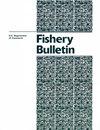Comparison of model types for prediction of seafloor trawlability in the Gulf of Alaska by using multibeam sonar data
IF 0.8
4区 农林科学
Q3 FISHERIES
引用次数: 1
Abstract
4 Alaska Regional Office National Marine Fisheries Service, NOAA P.O. Box 21668 Juneau, Alaska 99802 Abstract—Many rockfishes (Sebastes spp.) inhabit rugged areas of seafloor that are inaccessible to survey trawl gear. Their utilization of such habitat makes estimation of their abundance difficult. Furthermore, it is often difficult to assess whether habitat is trawlable or untrawlable and to estimate the spatial extent of both habitat types. To help determine trawlability for the continental shelf in the Gulf of Alaska, we used multibeam sonar data collected in the area during 2011, 2013, and 2015. These data were used to derive 3 characteristics of the seafloor: oblique incidence backscatter strength (Sb oblique), seafloor ruggedness, and bathymetric position index. Habitat type was categorized as trawlable or untrawlable through analysis of video from deployed drift cameras. We tested the effectiveness of the use of these seafloor characteristics in prediction of habitat trawlability with 4 types of models: generalized linear model, generalized additive model, boosted regression tree, and random forest. All 4 models perform moderately well at predicting trawlability across the shelf, and results from all of them indicate that Sb oblique is the most important characteristic in discriminating between trawlable and untrawlable habitat. These results indicate that multibeam sonar data can help determine habitat type, information that in turn can help improve habitatspecific estimates of biomass of marine fish species.利用多波束声纳数据预测阿拉斯加湾海底拖网能力的模型类型比较
摘要—许多岩鱼(海蛞蝓类)生活在崎岖的海底区域,这些区域是拖网渔具无法到达的。它们对这种栖息地的利用使它们的数量难以估计。此外,通常很难评估生境是可拖网捕捞还是不可拖网捕捞,也很难估计两种生境类型的空间范围。为了帮助确定阿拉斯加湾大陆架的拖网稳定性,我们使用了2011年、2013年和2015年在该地区收集的多波束声纳数据。利用这些数据得出了海底的3个特征:斜入射后向散射强度(Sb斜)、海底崎岖度和水深位置指数。通过分析部署的漂移摄像机的视频,将生境类型分为可拖网或不可拖网。我们使用广义线性模型、广义加性模型、增强回归树和随机森林4种模型来测试利用这些海底特征预测栖息地拖网性的有效性。4种模型均能较好地预测大陆架上的拖网可拖网性,结果表明斜倾角是区分可拖网生境和非可拖网生境的最重要特征。这些结果表明,多波束声呐数据可以帮助确定栖息地类型,这些信息反过来可以帮助提高对海洋鱼类物种生物量的栖息地特异性估计。
本文章由计算机程序翻译,如有差异,请以英文原文为准。
求助全文
约1分钟内获得全文
求助全文
来源期刊

Fishery Bulletin
农林科学-渔业
CiteScore
1.70
自引率
12.50%
发文量
76
审稿时长
>24 weeks
期刊介绍:
The quarterly Fishery Bulletin is one of the oldest and most respected fisheries journals in the world. It has been an official publication of the U.S. Government since 1881, under various titles, and is the U.S. counterpart to other highly regarded governmental fisheries science publications. It publishes original research and interpretative articles in all scientific fields that bear on marine fisheries and marine mammal science.
 求助内容:
求助内容: 应助结果提醒方式:
应助结果提醒方式:


